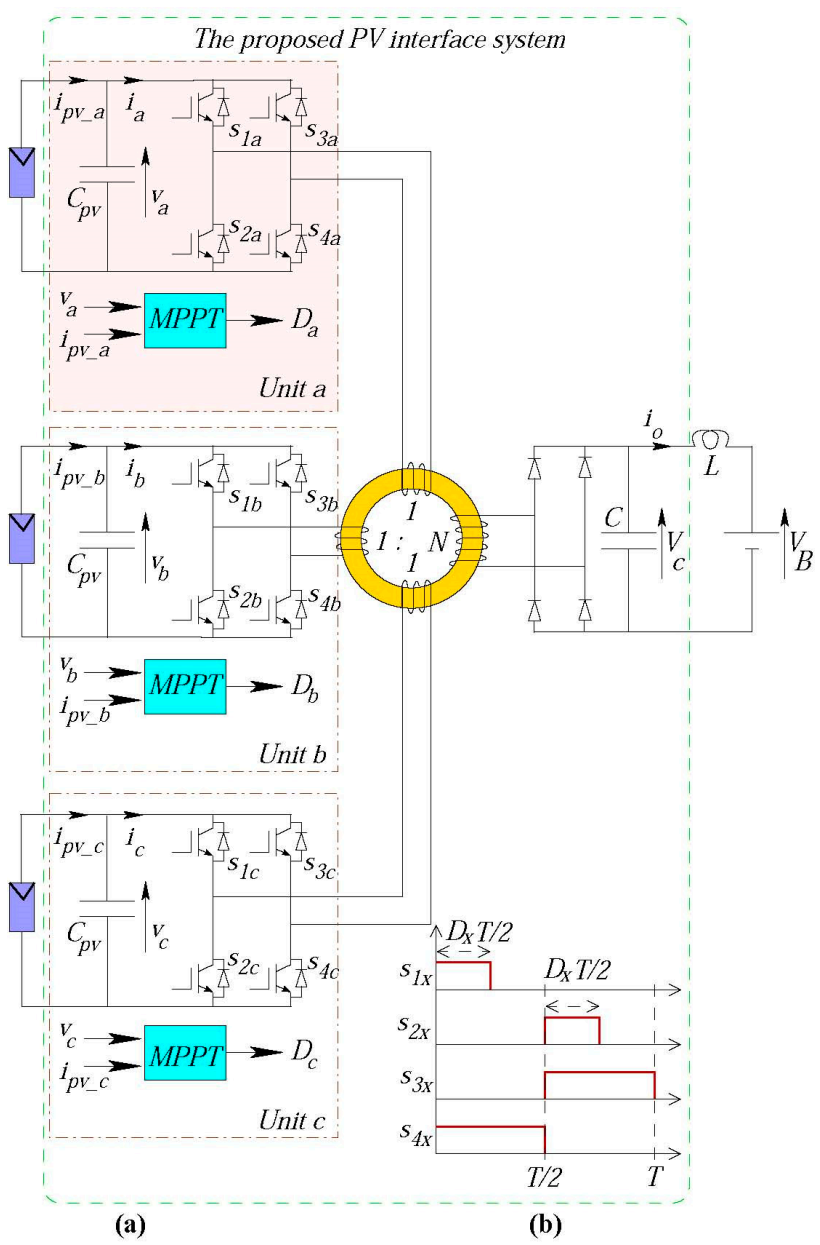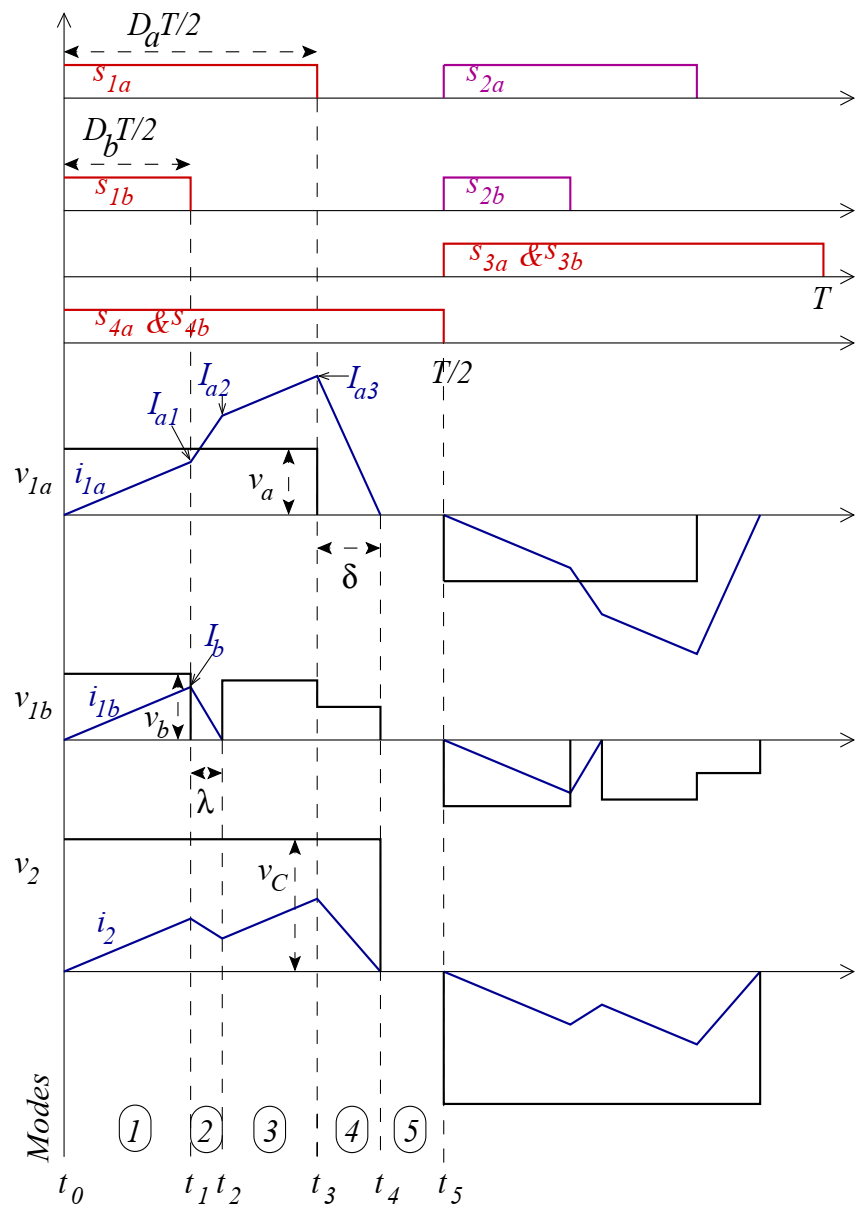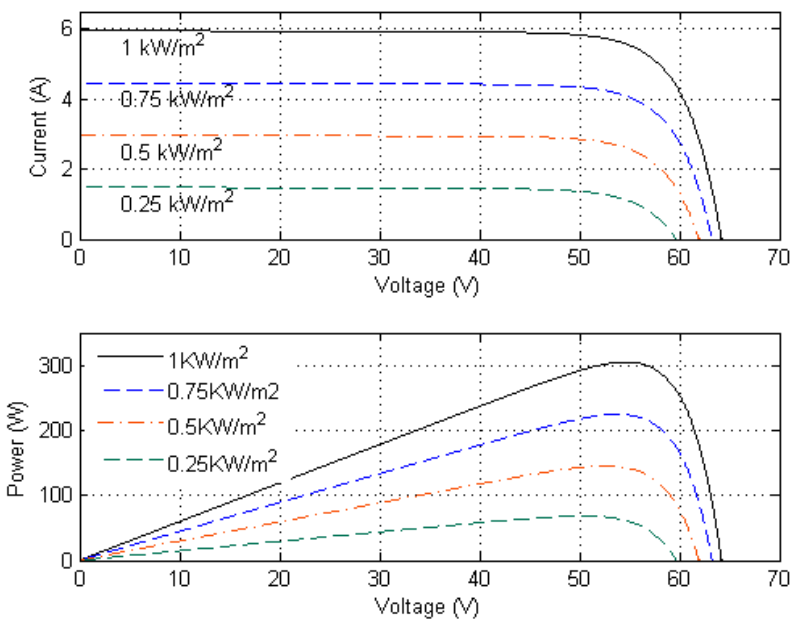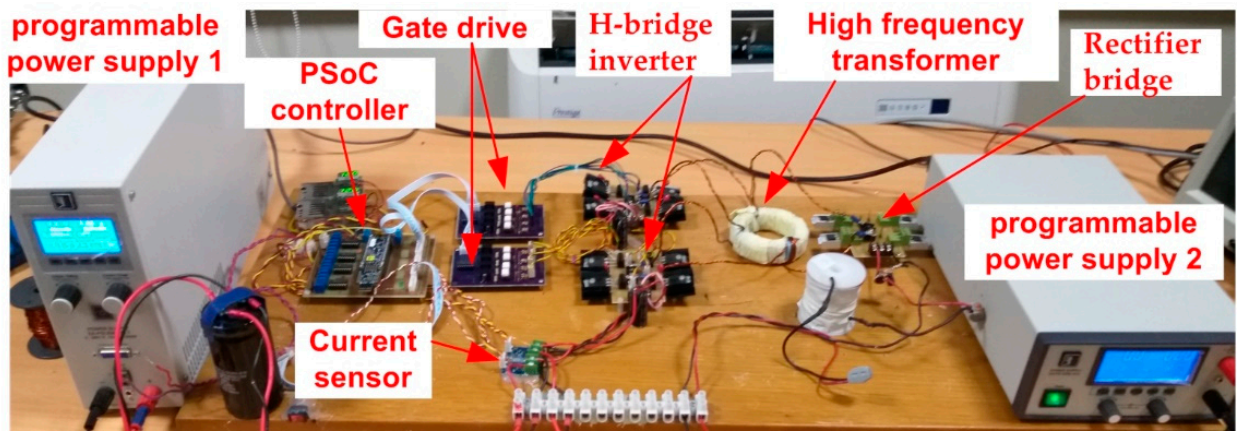Analysis and Design of a Multi-Port DC-DC Converter for Interfacing PV Systems
Abstract
:1. Introduction
2. The Proposed HFMP DC-DC Converter
3. Principles of Operation
3.1. Mode 1: t0–t1
3.2. Mode 2: t1–t2
3.3. Mode 3: t2–t3
3.4. Mode 4: t3–t4
3.5. Mode 5: t4–t5
4. Simulation Results
4.1. The Proposed Converter with Two Input Units Fed from DC Supplies
4.2. The Proposed Converter with Three Input Windings Fed from PV Modules
5. Experimental Results
6. Conclusions
Author Contributions
Funding
Institutional Review Board Statement
Informed Consent Statement
Data Availability Statement
Acknowledgments
Conflicts of Interest
List of Symbols
| λ: time duration of mode 2 | MP: multi-port |
| MPPT: maximum power point tracking | |
| δ: τιμε δυρατιον οφ μοδε 4 | P: output power |
| BCC: Boundary Current Conduction | Pa: unit ‘a’ output power |
| CHFL: Cascaded High Frequency Link | Pb: unit ‘b’ output power |
| D1x to D4x: H-bridge diodes of unit x | PPS: programmable power supply |
| Dx: duty cycle of H-bridge of unit x | PV: photovoltaic |
| DCM: discontinuous conduction mode | P&O: perturb and observe |
| E: transformer-induced voltage | PSoC: programmable system-on-chip |
| EMF: Electromagnetic force | |
| f: switching frequency | PWM: pulse width modulation |
| HFAC: high-frequency AC | STC: stander tested condition |
| HFDC: high-frequency DC | S1x to S4x: H-bridge switches of unit x |
| HFMP: high-frequency multi-port | i1x: transformer primary current of H-bridge of unit x |
| HFT: high-frequency transformers | T: switching period |
| i1x: transformer primary current of H-bridge of unit x | VB: DC bus voltage |
| i2:transformer secondary current | Vx: input DC voltage to H-bridge of unit x |
| Ia1: the current of unit ‘a’ at the end of this mode 1 | v1x: transformer primary voltage of H-bridge of unit x |
| Ia2: the current of unit ‘a’ at the end of this mode 2 | v2: transformer secondary voltage |
| Ia3: the current of unit ‘a’ at the end of this mode 3 | x: unit identifier = a, b, c, … |
| L1a, L1b: transformer leakage inductances at units a and b. | ZCS: zero-current switching |
Appendix A. ‘High-Frequency Transformer Design’
Appendix B. ‘Output Filter Design’

References
- Periyanayagam, M.; Kumar, V.S.; Chokkalingam, B.; Padmanaban, S.; Mihet-Popa, L.; Adedayo, Y. A Modified High Voltage Gain Quasi-Impedance Source Coupled Inductor Multilevel Inverter for Photovoltaic Application. Energies 2020, 13, 874. [Google Scholar] [CrossRef] [Green Version]
- Hwang, D.-H.; Lee, J.-Y.; Cho, Y. Single-phase single-stage dual-buck photovoltaic inverter with active power decoupling strategy. Renew. Energy 2018, 126, 454–464. [Google Scholar] [CrossRef]
- Hamed, A.S.; Marei, M.I.; Badr, M.A. PV interfacing system based on dual cascaded inverter. In Proceedings of the 2017 IEEE 6th International Conference on Renewable Energy Research and Applications (ICRERA), San Diego, CA, USA, 5 November 2017; pp. 93–100. [Google Scholar]
- Abdalla, I.I.; Corda, J.; Zhang, L. Multilevel DC-Link Inverter and Control Algorithm to Overcome the PV Partial Shading. IEEE Trans. Power Electron. 2012, 28, 14–18. [Google Scholar] [CrossRef]
- Mokhtar, M.; Marei, M.I.; El-Sattar, A.A. An adaptive droop control scheme for DC microgrids integrating sliding mode voltage and current controlled boost converters. IEEE Trans. Smart Grid 2017, 10, 1685–1693. [Google Scholar] [CrossRef]
- Leuenberger, D.; Biela, J. PV-Module-Integrated AC Inverters (AC Modules) with Subpanel MPP Tracking. IEEE Trans. Power Electron. 2017, 32, 6105–6118. [Google Scholar] [CrossRef]
- Guo, K.; Liu, Q.; Xi, X.; Mao, M.; Wan, Y.; Wu, H. Coordinated Control Strategy of a Combined Converter in a Photovoltaic DC Boost Collection System under Partial Shading Conditions. Energies 2020, 13, 474. [Google Scholar] [CrossRef] [Green Version]
- Costanzo, L.; Vitelli, M. A Novel MPPT Technique for Single Stage Grid-Connected PV Systems: T4S. Energies 2019, 12, 4501. [Google Scholar] [CrossRef] [Green Version]
- Qoria, T.; Li, C.; Oue, K.; Gruson, F.; Colas, F.; Guillaud, X. Direct AC voltage control for grid-forming inverters. J. Power Electron. 2020, 20, 198–211. [Google Scholar] [CrossRef]
- Jiang, Y.; Gao, F.; Pan, J. Single-phase Phase-shift Full-bridge Photovoltaic Inverter with Integrated Magnetics. Electr. Power Compon. Syst. 2010, 38, 832–850. [Google Scholar] [CrossRef]
- Marei, M.I.; Alajmi, B.N.; Abdelsalam, I.; Alhajri, M.F. A PV interface system based on high-gain high-frequency link con-verter. In Proceedings of the 2018 53rd International Universities Power Engineering Conference (UPEC), Glasgow, Scotland, UK, 4–7 September 2018; pp. 1–6. [Google Scholar]
- Karthikeyan, V.; Gupta, R. Varying phase angle control in isolated bidirectional DC–DC converter for integrating battery storage and solar PV system in standalone mode. IET Power Electron. 2017, 10, 471–479. [Google Scholar] [CrossRef]
- El-Helw, H.M.; Al-Hasheem, M.; Marei, M.I. Control Strategies for the DAB Based PV Interface System. PLoS ONE 2016, 11, e0161856. [Google Scholar] [CrossRef]
- Marei, M.I.; Elsayad, N.; El-Sattar, A.A. PV interface system with LVRT capability based on a current controlled HFAC link converter. Sustain. Energy Technol. Assess. 2015, 9, 55–62. [Google Scholar] [CrossRef]
- Moosavi, M.; Toliyat, H.A. A Scalable Soft-Switching Photovoltaic Inverter with Cascaded H-Bridge Cells and Galvanic Isolation. In Proceedings of the 2019 IEEE Applied Power Electronics Conference and Exposition (APEC), Anaheim, CA, USA, 17–21 March 2019; pp. 3230–3237. [Google Scholar]
- Iyer, K.V.; Baranwal, R.; Mohan, N. A High-Frequency AC-Link Single-Stage Asymmetrical Multilevel Converter for Grid Integration of Renewable Energy Systems. IEEE Trans. Power Electron. 2017, 32, 5087–5108. [Google Scholar] [CrossRef]
- Islam, R.; Guo, Y.; Zhu, J. A High-Frequency Link Multilevel Cascaded Medium-Voltage Converter for Direct Grid Integration of Renewable Energy Systems. IEEE Trans. Power Electron. 2014, 29, 4167–4182. [Google Scholar] [CrossRef]
- Essakiappan, S.; Krishnamoorthy, H.S.; Enjeti, P.; Balog, R.S.; Ahmed, S. Multilevel Medium-Frequency Link Inverter for Utility Scale Photovoltaic Integration. IEEE Trans. Power Electron. 2015, 30, 3674–3684. [Google Scholar] [CrossRef]
- Romero-Cadaval, E.; Spagnuolo, G.; Franquelo, L.G.; Ramos-Paja, C.A.; Suntio, T.; Xiao, W.M. Grid-Connected Photovoltaic Generation Plants: Components and Operation. IEEE Ind. Electron. Mag. 2013, 7, 6–20. [Google Scholar] [CrossRef] [Green Version]
- Ayang, A.; Saad, M.; Ouhrouche, M.; Wamkeue, R. Modeling, P&O MPPT and PI controls and performance analysis of PV/Energy storage hybrid power system. In Proceedings of the 2018 4th International Conference on Renewable Energies for Developing Countries (REDEC); Institute of Electrical and Electronics Engineers (IEEE): New York, NY, USA, 2018; pp. 1–6. [Google Scholar]
- Gunasekaran, D.; Umanand, L. Integrated magnetics based multi-port bidirectional DC–DC converter topology for discontinuous-mode operation. IET Power Electron. 2012, 5, 935–944. [Google Scholar] [CrossRef]
- Jakka, V.N.S.R.; Shukla, A.; Demetriades, G.D. Dual-Transformer-Based Asymmetrical Triple-Port Active Bridge (DT-ATAB) Isolated DC–DC Converter. IEEE Trans. Ind. Electron. 2017, 64, 4549–4560. [Google Scholar] [CrossRef]
- Buticchi, G.; Costa, L.F.; Barater, D.; Liserre, M.; Amarillo, E.D. A Quadruple Active Bridge Converter for the Storage Integration on the More Electric Aircraft. IEEE Trans. Power Electron. 2017, 33, 8174–8186. [Google Scholar] [CrossRef] [Green Version]
- Jafari, M.; Malekjamshidi, Z.; Lu, D.D.-C.; Zhu, J. Development of a Fuzzy-Logic-Based Energy Management System for a Multiport Multioperation Mode Residential Smart Microgrid. IEEE Trans. Power Electron. 2019, 34, 3283–3301. [Google Scholar] [CrossRef]
- Hebala, O.M.; Aboushady, A.A.; Ahmed, K.H.; Abdelsalam, I.; Burgess, S.J. A New Active Power Controller in Dual Active Bridge DC–DC Converter with a Minimum-Current-Point-Tracking Technique. IEEE J. Emerg. Sel. Top. Power Electron. 2021, 9, 1328–1338. [Google Scholar] [CrossRef]
- Shao, S.; Chen, H.; Wu, X.; Zhang, J.; Sheng, K. Circulating Current and ZVS-on of a Dual Active Bridge DC-DC Converter: A Review. IEEE Access 2019, 7, 50561–50572. [Google Scholar] [CrossRef]
- Qi, J.; Zhang, Y.; Chen, Y. Modeling and maximum power point tracking (MPPT) method for PV array under partial shade condi-tions. Renew. Energy 2014, 66, 337–345. [Google Scholar] [CrossRef]
- Al-Emam, M.; Marei, M.I.; El-khattam, W. A Maximum Power Point Tracking Technique for PV Under Partial Shading Condition. In Proceedings of the 2018 8th IEEE India International Conference on Power Electronics (IICPE), Jaipur, India, 13–15 December 2018; pp. 1–6. [Google Scholar]
- Alajmi, B.; Marei, M.I.; Abdelsalam, I. A Multi-Port DC/DC Converter based on Two- Quadrant Inverter Topology for PV Systems. IEEE Trans. Power Electron. 2021, 36, 522–532. [Google Scholar] [CrossRef]
- Ali, A.I.; Sayed, M.A.; Mohamed, E.E. Modified efficient perturb and observe maximum power point tracking technique for grid-tied PV system. Int. J. Electr. Power Energy Syst. 2018, 99, 192–202. [Google Scholar] [CrossRef]
- Khan, M.J.; Mathew, L. Comparative study of maximum power point tracking techniques for hybrid renewable energy system. Int. J. Electron. 2019, 106, 1216–1228. [Google Scholar] [CrossRef]
- Sunpower SPR-305-WHT-U (305) Solar Panel. Available online: http://www.solardesigntool.com/components/module-panel-solar/Sunpower/514/SPR-305-WHT-U/specification-data-sheet.html (accessed on 20 January 2021).
- Andersson, C. Design of a 2.5 kW DC-DC Full Bridge Converter. Master’s Thesis, Chalmers University of Technology, Göteborg, Sweden, 2011. [Google Scholar]
- Pereda, J.; Dixon, J. High-Frequency Link: A Solution for Using Only One DC Source in Asymmetric Cascaded Multilevel Inverters. IEEE Trans. Ind. Electron. 2011, 58, 3884–3892. [Google Scholar] [CrossRef]















| Variation in vx | Variation in Power | Dx |
|---|---|---|
| + | + | Dx − ΔD |
| + | − | Dx + ΔD |
| − | + | Dx + ΔD |
| − | − | Dx − ΔD |
| Input port voltage | 55 V |
| Average input port current | 5.6 A |
| Average output port current | 5.6 A |
| DC bus voltage, vB | 90 V |
| Turns ratio | 10:10:20 |
| L1a = L1b = L1 | 7.25 μH |
| L2 | 29 μH |
| L | 1 mH |
| C | 22 μF |
| Switching frequency | 10 kHz |
| PV Module Specifications [32] | |
|---|---|
| Model | Sunpower SPR-305-WHT |
| Maximum Power | 305 W at STC |
| Number of Cells | 96 |
| Current at MPP | 5.58 A |
| Voltage at MPP | 54.7 V |
| Open Circuit Voltage | 64.2 V |
| Short Circuit Current | 5.96 A |
| PPS of Unit ‘a’ | PPS of Unit ‘b’ | |
|---|---|---|
| Voltage | 51.8 V | 50.6 V |
| Power | 299 W | 143 W |
Publisher’s Note: MDPI stays neutral with regard to jurisdictional claims in published maps and institutional affiliations. |
© 2021 by the authors. Licensee MDPI, Basel, Switzerland. This article is an open access article distributed under the terms and conditions of the Creative Commons Attribution (CC BY) license (https://creativecommons.org/licenses/by/4.0/).
Share and Cite
Alajmi, B.N.; Marei, M.I.; Abdelsalam, I.; AlHajri, M.F. Analysis and Design of a Multi-Port DC-DC Converter for Interfacing PV Systems. Energies 2021, 14, 1943. https://doi.org/10.3390/en14071943
Alajmi BN, Marei MI, Abdelsalam I, AlHajri MF. Analysis and Design of a Multi-Port DC-DC Converter for Interfacing PV Systems. Energies. 2021; 14(7):1943. https://doi.org/10.3390/en14071943
Chicago/Turabian StyleAlajmi, Bader N., Mostafa I. Marei, Ibrahim Abdelsalam, and Mohamed F. AlHajri. 2021. "Analysis and Design of a Multi-Port DC-DC Converter for Interfacing PV Systems" Energies 14, no. 7: 1943. https://doi.org/10.3390/en14071943






